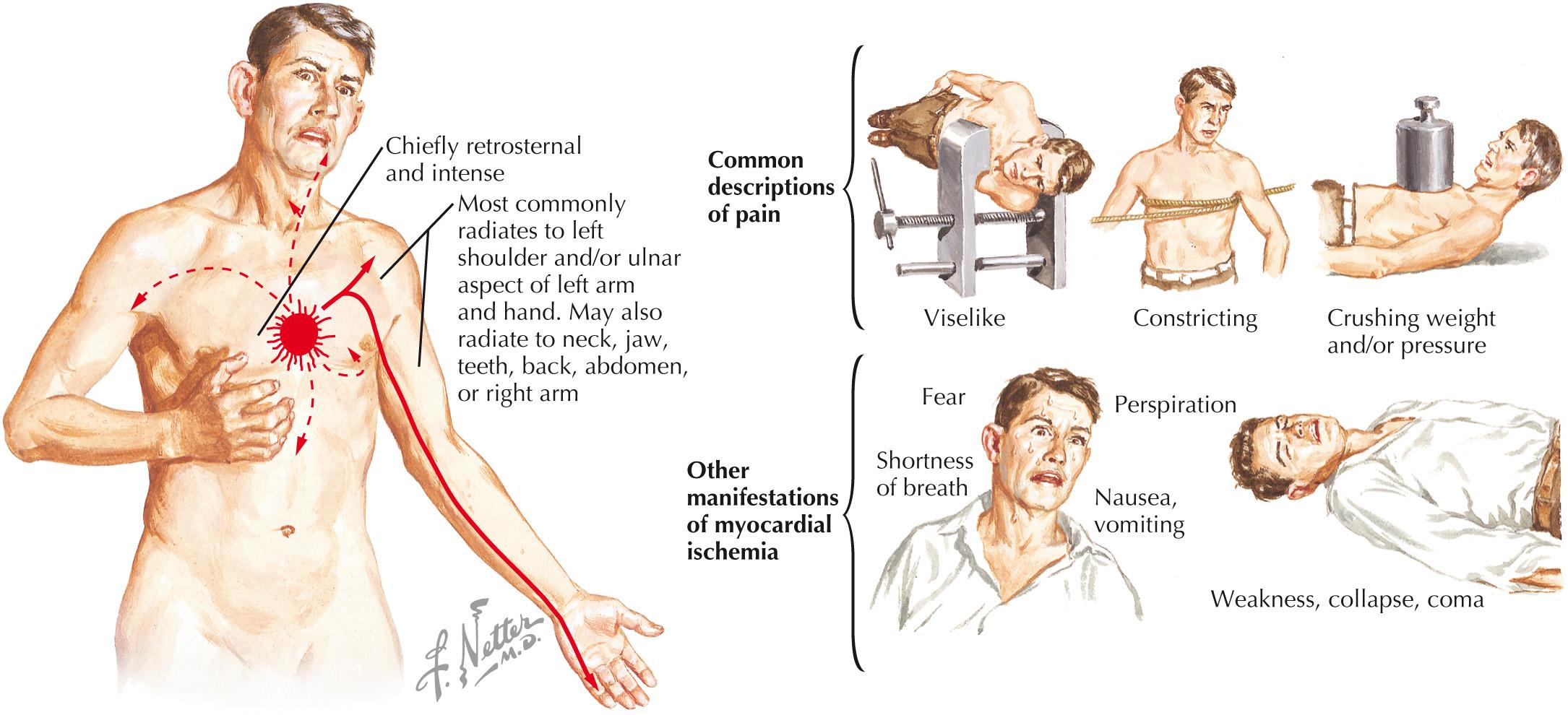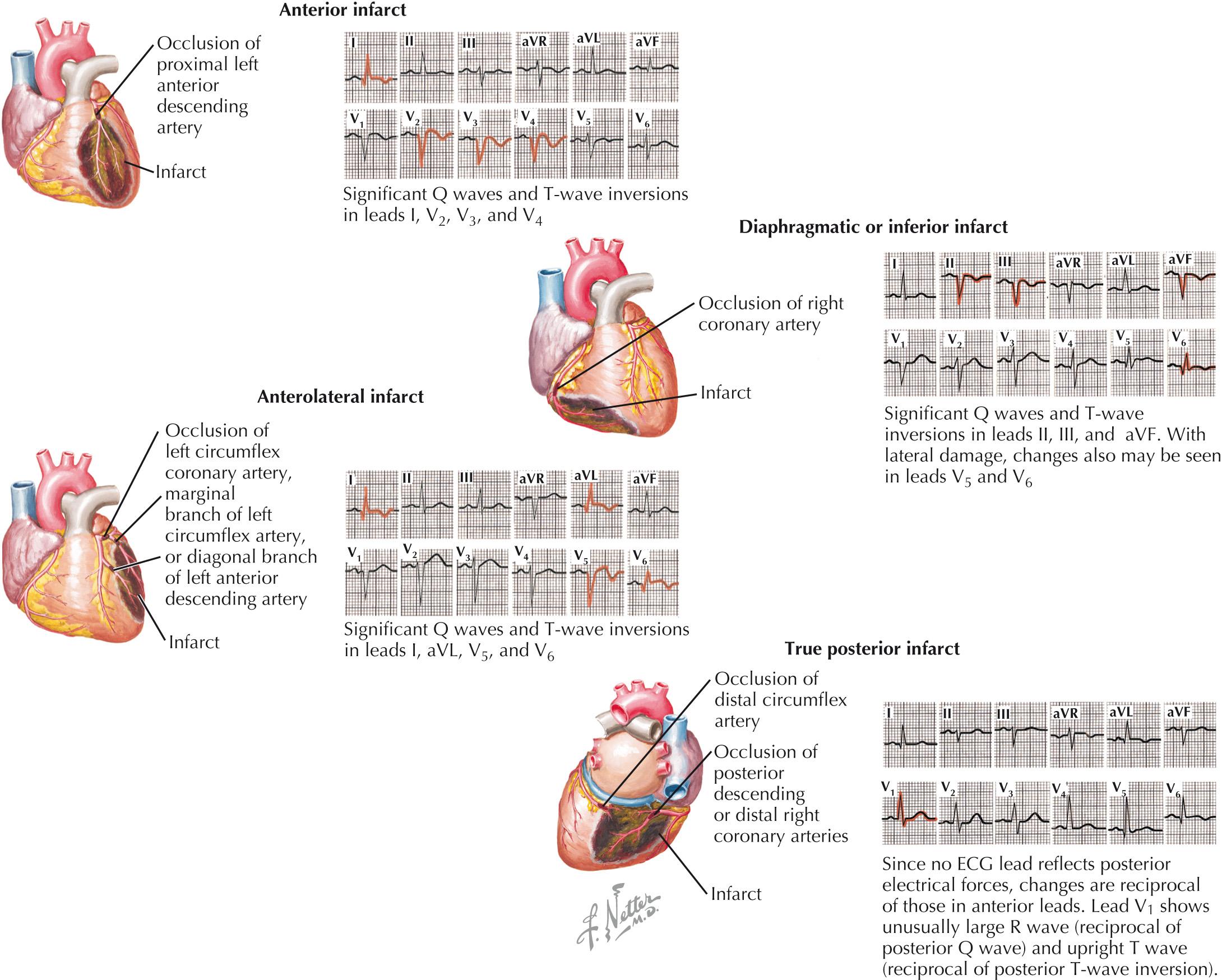Physical Address
304 North Cardinal St.
Dorchester Center, MA 02124
The diagnosis of acute coronary syndrome (ACS) is based on findings ranging from clinical presentation on ECG and/or biochemical findings to pathological characteristics. Patients with ACS include those whose clinical presentations cover the following range of diagnoses: unstable angina, non–ST-elevation myocardial infarction (NSTEMI), and ST-elevation MI (STEMI). An estimated 220,000 STEMI events per year occur in the United States.
The initial event in formation of an occlusive intracoronary thrombus is rupture or ulceration of an atherosclerotic plaque. Plaque rupture results in exposure of circulating platelets to the thrombogenic contents of the plaque, such as fibrillar collagen, von Willebrand factor, vitronectin, fibrinogen, and fibronectin. Adhesion of platelets to the ulcerated plaque, with subsequent platelet activation and aggregation, leads to thrombin generation, conversion of fibrinogen to fibrin, and further activation of platelets, as well as vasoconstriction, due in part to platelet-derived vasoconstrictors. This prothrombotic milieu promotes propagation and stabilization of an active thrombus that contains platelets, fibrin, thrombin, and erythrocytes, which results in occlusion of the infarct-related artery ( Fig. 21.1A ). Upon interruption of antegrade flow in an epicardial coronary artery, the zone of myocardium supplied by that vessel immediately loses its ability to perform contractile work ( Fig. 21.1B ). Abnormal contraction patterns develop: dyssynchrony, hypokinesis, akinesis, and dyskinesis. Myocardial dysfunction in an area of ischemia is typically complemented by hyperkinesis of the remaining normal myocardium due to acute compensatory mechanisms, including increased sympathetic nervous system activity. Etiologies other than plaque rupture are far less common and include coronary artery spasm (which is often due to cocaine), thromboembolism in the setting of atrial fibrillation or a mechanical heart valve, and hypercoagulable states that lead to intracoronary thrombus formation.

Typical prodromal symptoms are present in many patients but not in all patients who present with an acute MI. Of these, chest discomfort, which resembles classic angina pectoris but occurs at rest or with less activity than usual, is the most common symptom. The intensity of MI pain is variable, usually severe, and in some instances intolerable. Pain is prolonged, usually lasts >30 minutes, and frequently lasts for hours. The discomfort is typically described as constricting, crushing, oppressing, or compressing. The pain is usually retrosternal, frequently spreading to both sides of the anterior chest, with predilection for the left side. In some instances, pain of an acute MI may begin in the epigastric area and simulate a variety of abdominal disorders. In other patients, MI discomfort radiates to the shoulders, neck, jaw, or back ( Fig. 21.2 ). In some patients, particularly older adults, an MI is manifested clinically not by pain but by symptoms of acute left ventricular (LV) failure and chest tightness, or by marked weakness or frank syncope. These symptoms may be accompanied by diaphoresis, nausea, and vomiting.

Numerous findings may be present in the patient who presents with an acute MI. LV dysfunction may also result in pulmonary edema, hypotension, and decreased peripheral perfusion with cool extremities and mottling. In addition, patients with acute mitral valve regurgitation may present with marked evidence of LV dysfunction and may have an audible holosystolic murmur upon presentation. A third heart sound usually reflects severe LV dysfunction with elevated filling pressures. Marked jugular venous distention and v waves consistent with tricuspid regurgitation are evident in right ventricular infarction.
The pain of an acute MI may simulate the pain of acute pericarditis, which is usually associated with some pleuritic features and aggravated by respiratory movements and coughing. Pleural pain is typically sharp, knifelike, and aggravated in a cyclic fashion by each breath. These features distinguish pleural pain from the deep, dull, steady pain of an acute MI. Pulmonary embolism generally produces pain laterally in the chest, is often pleuritic, and may be associated with hemoptysis. Pain from acute dissection of the aorta is usually localized in the center of the chest or back, is extremely severe, persists for many hours, often radiates to the back or lower extremities, and reaches maximal intensity shortly after onset of the pain. Often, one or more major arterial pulses are absent. Pain arising from the costochondral and chondrosternal articulations is characterized by marked localized tenderness. The pain of an acute MI, particularly of an inferior MI, may also simulate the pain of esophageal spasm, peptic ulcer disease, or stress gastritis.
A pattern of ST-segment elevation, especially with associated T-wave changes and ST depression in another anatomic distribution (“reciprocal changes”), combined with chest pain persisting >20 minutes is highly indicative of STEMI ( Fig. 21.3 ). To meet the ECG criteria for STEMI, the ST segment must be elevated in at least two contiguous leads by >0.2 mV in leads V 2 and V 3 in men (0.15 mV in women) and/or by >0.1 mV in other leads. Patients with ACS are also considered to have a STEMI in the absence of ST-segment elevation if a new left bundle branch block (LBBB) or a true posterior MI is present. Many factors limit the ability of ECGs to diagnose and localize an MI; these include the extent of the myocardial injury, the age of the infarct, conduction defects, previous infarcts or acute pericarditis, changes in electrolyte concentrations, and the administration of cardioactive drugs. In addition, some patients with an acute MI do not have significant ST changes because of the location of the infarction. For these reasons, even in the absence of STEMI ECG criteria, severe myocardial ischemia necessitating therapy may be present. With an appropriate clinical history, it may be necessary to pursue further diagnostic testing to rule out acute MI.

Become a Clinical Tree membership for Full access and enjoy Unlimited articles
If you are a member. Log in here